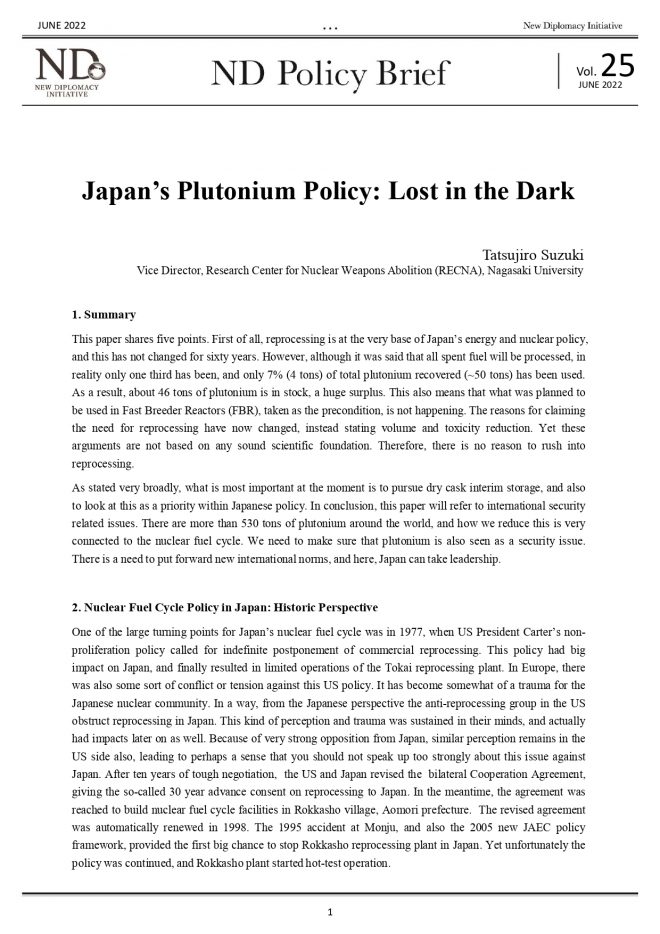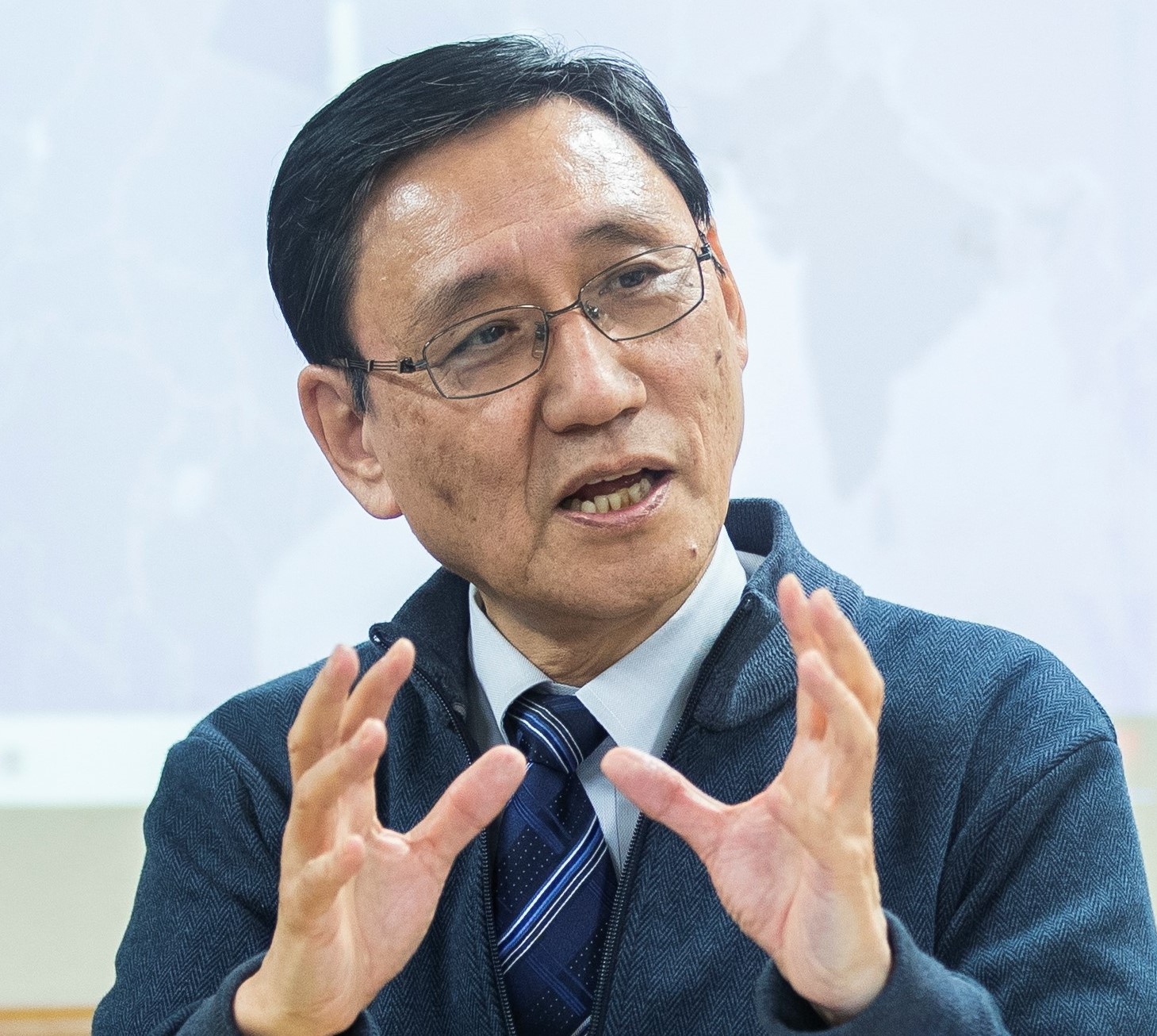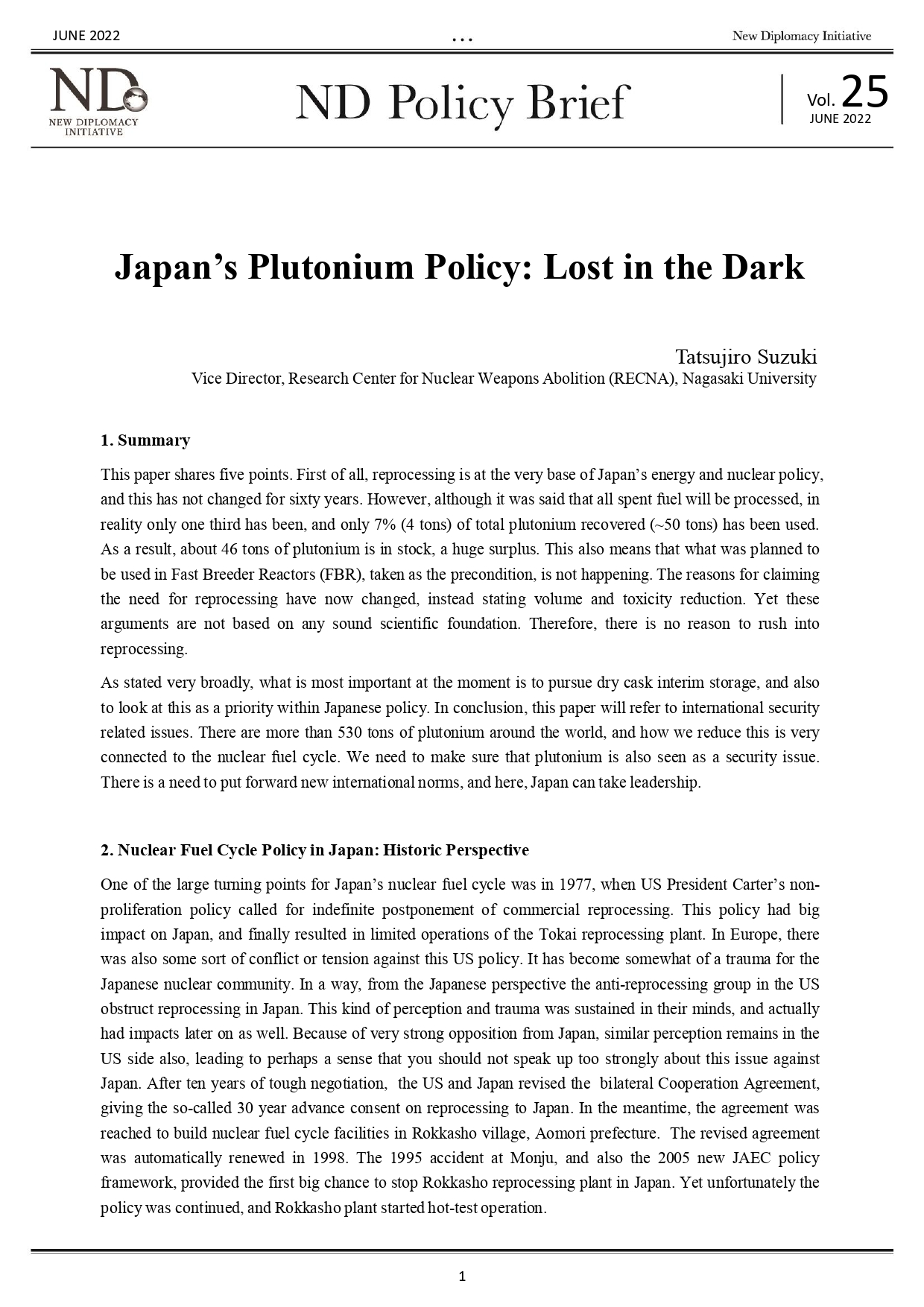Tatsujiro Suzuki
Vice Director, Research Center for Nuclear Weapons Abolition (RECNA), Nagasaki University
1. Summary
This paper shares five points. First of all, reprocessing is at the very base of Japan’s energy and nuclear policy, and this has not changed for sixty years. However, although it was said that all spent fuel will be processed, in reality only one third has been, and only 7% (4 tons) of total plutonium recovered (~50 tons) has been used. As a result, about 46 tons of plutonium is in stock, a huge surplus. This also means that what was planned to be used in Fast Breeder Reactors (FBR), taken as the precondition, is not happening. The reasons for claiming the need for reprocessing have now changed, instead stating volume and toxicity reduction. Yet these arguments are not based on any sound scientific foundation. Therefore, there is no reason to rush into reprocessing.
As stated very broadly, what is most important at the moment is to pursue dry cask interim storage, and also to look at this as a priority within Japanese policy. In conclusion, this paper will refer to international security related issues. There are more than 530 tons of plutonium around the world, and how we reduce this is very connected to the nuclear fuel cycle. We need to make sure that plutonium is also seen as a security issue. There is a need to put forward new international norms, and here, Japan can take leadership.
2. Nuclear Fuel Cycle Policy in Japan: Historic Perspective
One of the large turning points for Japan’s nuclear fuel cycle was in 1977, when US President Carter’s non-proliferation policy called for indefinite postponement of commercial reprocessing. This policy had big impact on Japan, and finally resulted in limited operations of the Tokai reprocessing plant. In Europe, there was also some sort of conflict or tension against this US policy. It has become somewhat of a trauma for the Japanese nuclear community. In a way, from the Japanese perspective the anti-reprocessing group in the US obstruct reprocessing in Japan. This kind of perception and trauma was sustained in their minds, and actually had impacts later on as well. Because of very strong opposition from Japan, similar perception remains in the US side also, leading to perhaps a sense that you should not speak up too strongly about this issue against Japan. After ten years of tough negotiation, the US and Japan revised the bilateral Cooperation Agreement, giving the so-called 30 year advance consent on reprocessing to Japan. In the meantime, the agreement was reached to build nuclear fuel cycle facilities in Rokkasho village, Aomori prefecture. The revised agreement was automatically renewed in 1998. The 1995 accident at Monju, and also the 2005 new JAEC policy framework, provided the first big chance to stop Rokkasho reprocessing plant in Japan. Yet unfortunately the policy was continued, and Rokkasho plant started hot-test operation.
The next big chance was in 2011 following the Fukushima Daiichi nuclear power plant disaster under the Democratic Party of Japan(DPJ) Government. I was within the government at that time. There was a complete review of nuclear energy policy, including nuclear fuel policy. However, the policy to reprocess all spent fuel policy was not changed. In 2018, when US-Japan bilateral agreement was about to be renewed, there was a lot of quiet pressure on Japan from the US. The Japanese Atomic Energy Commission (JAEC) announced that it would “reduce its plutonium stockpile, or not have any further increases”. This policy was included in the new National Energy Plan, adopted by a Cabinet decision as well, and thus we hope will have quite an impact on future reprocessing.
3. Collapsed Dream: Fast Breed Reactors and the Nuclear Fuel Cycle
The dream of the FBRs of course collapsed, as shown in the graphs shared by Dr. Frank von Hippel (Figure 1, see PDF). On the left, we can see the projection in the US as of 1974. expecting that nuclear power will grow up to 2,500 GWeby 2010. The black line (less than 100 GWe) is the actual capacity in the US. The reality is clearly completely different, as a global situation, including in Japan. In 1985, Japan said that it would have 100 gigawatts by 2050. However, the reality here is also very different. There was also an expectation that in order FBRs to be commercially viable, the price of uranium should rise, and reprocessing cost should decline. However, we can see that the reality that uranium price has declined, while reprocessing cost has sharply increased. There are therefore no economic grounds for commercialization of nuclear fuel cycle.
4. Commercialization of FBR is fading away…
In Japan, the JAEC’s long-term plans for commercialization of FBRs were more and more delayed as time passed . At first, the commercialization goal was set by the mid-1970s, and of course this became later and later. In 1987, it was said that LWRs would be “a main power source for the foreseeable future,” in 2000, FBRs became a “future energy source.” In 2015 no concrete goal was even given, and it was stated as “the latter half of the 21st century,” showing how this commercialization goal became weaker and weaker, actually disappearing even within the JAEC itself. The Ministry of Economy, Trade and Industry (METI) Energy Agency’s graphs of nuclear fuel cycle (Figure 2) used to show both LWRs and FBRs cycles together, saying that both cycles are necessary, but this has now stopped. As a result, as the FBR commercialization is more and more delayed, nuclear fuel cycle became less realistic just with the LWRs only, then MOX spent nuclear fuel has to be ‘just disposed of’ as nuclear waste. However, direct disposal of spent fuel is not actually allowed under the current Japanese reprocessing policy. There was also a change in the law regarding reprocessing in 2016, meaning that operators have to cover the costs of reprocessing of all spent fuels, including MOX fabrication as well, which has led to this surplus of plutonium stocks.
5. Rationales for Nuclear Fuel cycle: Volume and Toxicity Reduction of nuclear waste argued by METI
In Japan, METI is also now arguing new rationales for reprocessing, which are the reduction of volume and toxicity of high level nuclear waste. They do acknowledge that the cost of reprocessing is high, but only the lowest figures are shown (Table 1, Table 2).
JAEC did compare the costs, and this table shows cost for reprocessing is about double of direct disposal. In addition, total estimated costs of both policies were compared within just the limited period of calculations up to 2030. The result was 18 versus 14 trillion yen, so a cost difference of 4 trillion yen. That would mean the difference of around 200 billion yen per year. However looking at the figures from China, this could be even more. This was somewhat of a conservative estimate, but these annual additional costs would be necessary with reprocessing.
As for the reduction of volume,it can be argued that FBR cycle produces much less waste volume than LWR once-through cycle. But volume reduction is not so significant if we compare once-through cycle with LWR/MOX recycle as we need to add MOX spent fuel as a nuclear waste. In addition, waste volume from LWR/MOX recycle could be larger than once-through cycle as we need to add low-level waste from reprocessing (Figure 3). As for the toxicity reduction, there is quite a misleading argument that toxicity reduction is risk reduction. There is a very small footnote under this widely used graph saying that the barriers to reduce risk are not considered here, but most people would not actually notice or realize this (Figure 4).
When I explain this to different parliament members, I use this example demonstrating risk, asking which is more dangerous: two tigers in a cage or one outside? (Figure 5) . Reprocessing is taking something which is kept in a cage outside, and letting it loose on the surface. This is the difference between toxicity and risk. The previous graph only shows how long it takes to have less tigers, but not the difference between what it actually means to take the tigers out of the cage, which of course increases the risks.
When we look at the actual OECD figures (Table 3) on the risk(radiation exposure) reduction, first from mining and refining, we can see radiation exposure ofonce-through is higher than that of reprocessing as the latter requires less uranium. But if we look at reprocessing, and storage after separating the plutonium, the radiation exposure of recycling is much higher than once-through. This diagram was righly considered at the JAEC discussions then, leading to their conclusion that there is no merit or actual improvement of reprocessing in terms of risk reduction, but this has not yet come out in any METI information.
6. Why can’t reprocessing be stopped?
So why can’t reprocessing be stopped? One of the reasons always given is that there is no capacity for spent fuel storage. An additional reason is the promise made by the utility to the local community, and the third reason is that the parties who cancel the project would have to bear the cost and they would have to go and apologize to Aomori prefecture. Nobody is willing to make that decision to take a huge financial risk which is in the order of trillions of yens.
Another reason is security issues. Some argue that having reprocessing capacity and plutonium can provide potential “latent nuclear deterrence” capability which is another reason not to stop reprocessing. Personally, I would like to emphasize the last point. In Japan, there is no independent oversight organization. This is the most important point for democratic system. The real victims of continuing nuclear fuel cycle would be the citizens, and the international community. Non-governmental oversight organizations can play important role, but their influence could be limited. I believe such independent oversight organization established by either the government or the Diet is critically important.
7. Risk of Spent Fuel Pool Storage vs Dry Cask Storage
Let us look also at the risks of spent fuel storage. This is a photograph (Figure 6) of Unit 4 at the Fukushima Daiichi Nuclear Power Plant, where hydrogen explosion occurred. At that time, there was a great concern that there would be no water left. Fortunately, there was water, but of course, if the water had been completely gone, there would have been a great risk. Therefore the safer method is dry cask storage. This photograph, also from the Fukushima Daiichi site, shows that while the building of storage facility itself was damaged by the Tsunami, the spent fuel was safe within the dry cask storage. Dry cask storage is air-cooled and does not require electricity, and thus power loss does not affect the safety at all.
Looking also at global plutonium stockpile trends, we can see that the amount for military use has reached its peak, but there has been a huge increase in civilian plutonium (Figure 7). Country by country chart (Figure 8) shows that, the UK, Russia, France, all of them are nuclear weapon states, and then also Japan have almost all of the global civilian plutonium. As mentioned today, China is coming into this, and we may see an increase there. Germany and other countries which conducted reprocessing in the past used to have some civilian plutonium, but barely none by now. It is mostly held by these four countries. So, like in the UK, if we can stop reprocessing in Russia, Japan, France, and possibly China, we will see a reduction in civilian plutonium stockpiles overall.
8. Recommendations
A study group established by the Sasakawa Peace Foundation recently made several recommendations for Japan, and emphasized the role Japan can play in proposing new international norms for plutonium management. Five main recommendations were the following. First, Japan can define “excess” plutonium which Japan cannot use for a foreseeable future, and put it under the custody of the International Atomic Energy Agency as a way to deal with various international concerns. Second, Japan can recommend recent JAEC’s policy to decrease or not to have any increase in stocks as a new norm to be adopted by the international plutonium management guidelines(INFCIRC/549). Third, Japan can set up international forum to facilitate international cooperation toward actual reduction of existing stocks. Fourth, Japan should give first priority to dry cask storage for spent fuel management. In addition, as mentioned, it suggested having an independent, third-party agency involved in assessing options for the nuclear fuel cycle. Finally, it proposes that Japan play a leading role in globally promoting new international norms for plutonium.
※This paper is based on the author’s presentation at the international symposium “Growing Plutonium Stockpiles and the Rokkasho Reprocessing Plant: Reality of Nuclear Fuel Cycle and Security in East Asia” , Dec. 18-19, 2021. The views expressed here are those of the author.
※This project is supported by a grant from “act beyond trust” (abt) .




